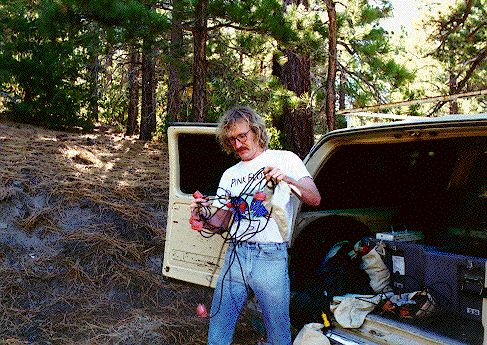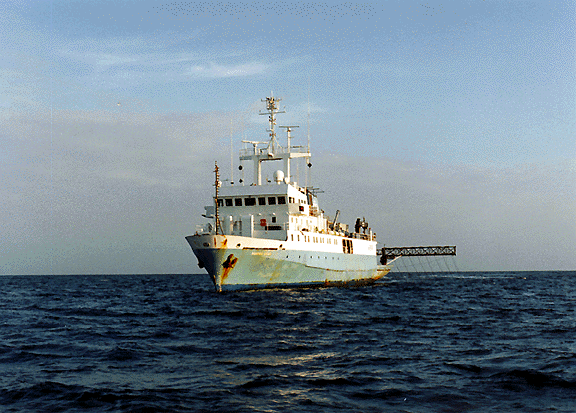IMAGES FROM THE LOS ANGELES REGION SEISMIC EXPERIMENT
Below are a series of photos illustrating the types of instruments that were
used, how the instruments were deployed, and the nature of the activities
at the "LARSE headquarters" in a Glendora Warehouse.
(Photos provided by Michael Forrest

LARSE "HEADQUARTERS"
In order to coordinate the field activities of the various phases of the LARSE,
a central hub site was set up in a Glendora Warehouse. Instruments were picked
up, deployed and returned to this location, where the data was then downloaded
to computers and tapes.

Principal Investigator Gary Fuis (U.S. Geological Survey, Menlo Park) explains
the LARSE to volunteers from local colleges.

Principal Investigator David Okaya (USC and SCEC)
organizing
activities at the Glendora facility.

SGR instruments from Stanford University are prepared
for deployment
by Michelle Robertson (USC) and Janice Murphy (USGS).

REFTEK instruments and seismometers are checked in at the Glendora facility.

Aaron Martin (UC Santa Barbara) supervises the downloading of data.

TYPES of INSTRUMENTS DEPLOYED

The blue box holds a Canadian EDA instrument; the tops of three seismometers (shown
below) are visible in the box to the right.


This metal cylinder houses a three-component seismometer
used with
the Canadian EDA instruments.

These orange geophones were another type of "seismometer" hooked up to
recording instruments such as the SGR's (shown below). At times it could be quite
challenging to untangle the cables as Michael Forrest (USC)
is demonstrating
here.

These SGR's from Stanford University, were yet another type of instrument
deployed to record the arrival of seismic waves from the land explosions.
These instruments record the data to a internal tape.

External GPS (Global Positioning Satellite) clocks were
hooked up to REFTEK recording devices in order to keep
accurate times for determining the arrivals of seismic
waves
at the recording stations.

Hundreds of batteries were required to provide power to the
instruments
deployed out in the field. (Sergio Chavez
(University of Nevada
at Reno) makes sure that the batteries are recharged)

DEPLOYING INSTRUMENTS

Alan Walter deploys a REFTEK instrument at the Seal Beach Weapons
station. An external GPS, a REFTEK, and a battery are evident.
The buried cable and seismometer lie to the right of his feet.
Nuclear weapons are stored in the bunker behind him.

Many instruments had to be hand carried into sites not accessible
to vehicles.
Here instruments are being packed into the Vincent Gap
in the San Gabriel
Mountains.
The blue instrument is an EDA, the white one is an SGR.

Installing a REFTEK in the San Gabriel Mountains. These
stations were camouflaged and often buried. Occasionally they were so
well hidden that they were later quite difficult to find again.

OFFSHORE AND ONSHORE EXPLOSIONS
A number of artificial "seismic wave" sources were generated as part of the
LARSE experiment. During the marine portion of the experiment, source
shots were supplied by
the R/V Ewing from Lamont-Doherty Earth Observatory at Columbia University.

A view of the R/V Ewing showing the 8000+ cubic inch airgun sources
mounted on the back of the ship. Individual airgun busts from these
sources could be seen at stations 200 km away.
During the land portion of LARSE, 63 explosions were set off at
various locations along a line extending from Seal Beach
over the San Gabriel Mountains and into the Mojave Desert at Harper Lake.

A "pre-explosion" shot casing.

A "post-explosion" shot casing.






![]()











